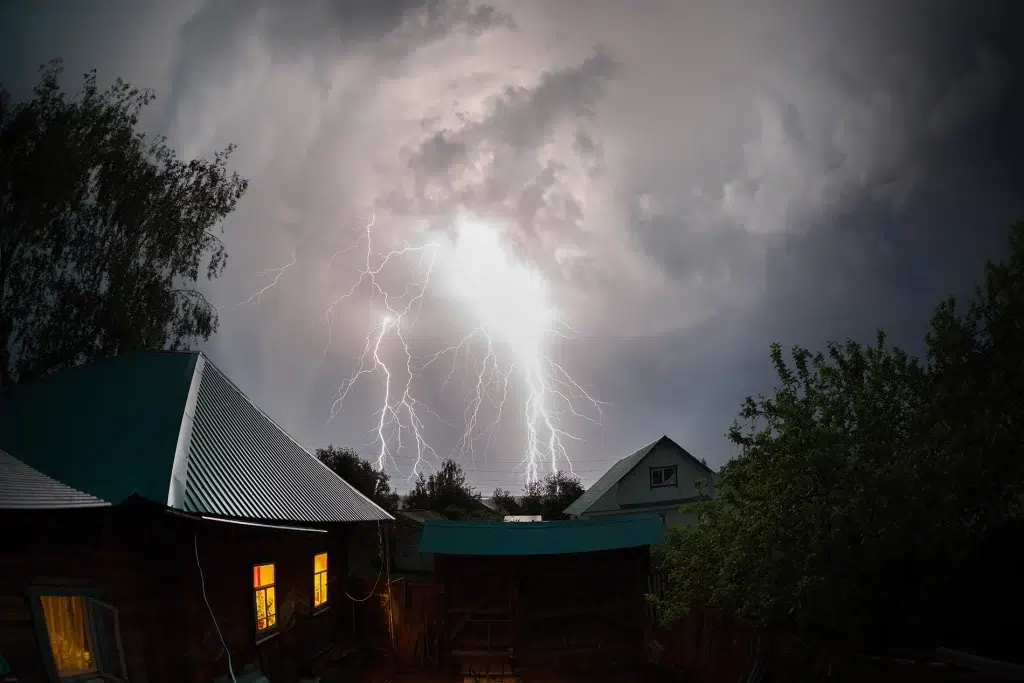Your roof is one of the most critical parts of your home. It protects you from harsh weather conditions and ensures the safety and comfort of everyone inside. Over time, they may suffer damage that requires repair or a full replacement.
Coverage depends on several factors. These include the cause of the damage, the age of your roof, and the details of your specific insurance policy. Discover the keys to how to get insurance to pay for your roof replacement.
How Roof Coverage Works
Homeowners insurance protects your property from unexpected events like natural disasters, accidents, and theft. Roof coverage is an essential part of most homeowners insurance policies.
However, coverage for your roof is not automatic or guaranteed. Insurance companies consider several factors when deciding whether to pay for a roof replacement.
If your roof is relatively new and has been well-maintained, your insurance is more likely to cover damages caused by storms.


How Roof Coverage Works
Homeowners insurance protects your property from unexpected events like natural disasters, accidents, and theft. Roof coverage is an essential part of most homeowners insurance policies.
However, coverage for your roof is not automatic or guaranteed. Insurance companies consider several factors when deciding whether to pay for a roof replacement.
If your roof is relatively new and has been well-maintained, your insurance is more likely to cover damages caused by storms.
Requirements for Homeowners Insurance to Cover Roof Replacement
For your homeowners insurance to cover a roof replacement, several criteria usually need to be met:
- Age and Condition of the Roof: Insurance companies are more likely to cover roofs that are newer. Many policies set an age limit on the roofs they will cover, often between 10 to 20 years. If your roof is older, the insurance company may only pay for its depreciated value or deny coverage altogether.
- Weather-Related Damage: Homeowners insurance typically covers damage caused by weather events. However, the damage must be sudden and accidental, not the result of gradual wear and tear.
- Types of Roof Materials: The type of material used on your roof can also affect coverage. Asphalt shingles, metal roofing, and other durable materials may have different coverage terms. Insurance companies often prefer roofs made from materials with longer lifespans and lower susceptibility to damage.
- Regular Roof Inspections: Regular maintenance and inspections can significantly influence coverage decisions. Insurance companies may ask for proof that you’ve regularly inspected and maintained your roof.
Reasons Homeowners Insurance Won’t Cover Roof Replacement
Homeowners insurance companies may deny a roof replacement in certain situations. Common exclusions include:
- Wear and Tear from Age: Insurance policies typically do not cover damage from the natural aging of your roof. As a roof gets older, it becomes more susceptible to leaks and other issues.
- Neglect or Lack of Maintenance : If your roof isn’t well-maintained, your insurance company might reject your claim.
- This could include issues like not replacing missing shingles or failing to address leaks promptly.
- Gradual Damage vs. Sudden Events: Insurance usually covers damage caused by sudden, unforeseen events. Gradual damage, such as deterioration over time due to exposure to the elements, is not covered.
- DIY Roof Replacements and Unprofessional Installations: Insurance companies might refuse to cover roofs installed incorrectly.

Roof Replacement Cost: What to Expect
Replacing a roof usually costs between $5,000 and $10,000. This price depends on factors like the size of the roof, the type of materials used, and your location. Several factors affect the overall cost. These include the square footage of your roof, the roofing material, and local labor costs. If your roof has structural damage that needs fixing, it can also add to the cost. If the damage is minor, repairs might be enough, which can lower your expenses. However, if your roof is old and nearing the end of its lifespan, replacing it could be a more cost-effective choice.

Roof Replacement Cost: What to Expect
Replacing a roof usually costs between $5,000 and $10,000. This price depends on factors like the size of the roof, the type of materials used, and your location. Several factors affect the overall cost. These include the square footage of your roof, the roofing material, and local labor costs. If your roof has structural damage that needs fixing, it can also add to the cost. If the damage is minor, repairs might be enough, which can lower your expenses. However, if your roof is old and nearing the end of its lifespan, replacing it could be a more cost-effective choice.
Filing an Insurance Claim for Roof Replacement
If your roof has suffered damage and you believe it qualifies for insurance coverage, here’s how to file a claim.
- Document the Damage: Start by taking detailed photos of the damage from different angles. Hire a roofing contractor to perform an inspection and provide a written report on the extent of the damage.
- Review Your Policy: Review your homeowners insurance policy to understand what’s covered and any exclusions. Look for details on your roof coverage, including age limitations and specific perils covered.
- Contact Your Insurance Company: Notify your insurance company as soon as possible. They will likely send an adjuster to inspect the damage and determine the validity of your claim. Be prepared to provide all necessary documentation, including photos and inspection reports.
- Work with a Roofing Contractor: Engage a reputable roofing contractor to provide an estimate for the repair or replacement. Many contractors can help with the claims process by providing detailed estimates that meet the insurance company’s requirements.
- Follow Up on Your Claim: Contractors provide detailed estimates that meet insurance company requirements. Ensure that you meet all deadlines and provide any additional information requested.
The Role of Roofing Companies in Insurance Claims
Roofing companies play a crucial role in the insurance claim process. Here’s how they can help:
- Assistance with Claims: Reputable roofing companies are experienced in working with insurance claims. They guide you through the process and ensure you submit the documentation correctly.
- Choosing a Local Roofing Company: Choose a local roofing company with a strong reputation in your community. Local contractors are more likely to understand regional building codes and weather conditions that could affect your roof.
- Hiring Licensed and Insured Contractors: Always hire a licensed roofing contractor. This ensures quality work and protects you from accidents or damage during the roof replacement.
Common Pitfalls and Mistakes in Filing a Roof Insurance Claim
Filing an insurance claim for roof replacement can be complex, and there are several common mistakes to avoid:
- Miscommunication with the Insurance Company: Clear communication with your insurance company is vital. Misunderstandings or miscommunication can result in a denied claim or less coverage than you expected.
- Underestimating Repair or Replacement Costs: It’s essential to get a comprehensive estimate from a qualified roofing contractor. Underestimating the costs can leave you paying more out of pocket if the insurance company’s payout falls short.
Storm Chaser Scammers: A Warning
After a major storm, you may be approached by contractors offering to repair or replace your roof. Be cautious—some of these could be “storm chasers” looking to take advantage of homeowners in distress. Storm chasers are contractors who travel to areas hit by severe weather events and offer quick, often substandard repairs. They might pressure you to sign a contract immediately or offer to cover your insurance deductible. This is insurance fraud. Working with a reputable, local contractor is the best way to avoid scams. Local contractors are more likely to stand by their work and be available for follow-up if issues arise.


Storm Chaser Scammers: A Warning
After a major storm, you may be approached by contractors offering to repair or replace your roof. Be cautious—some of these could be “storm chasers” looking to take advantage of homeowners in distress. Storm chasers are contractors who travel to areas hit by severe weather events and offer quick, often substandard repairs. They might pressure you to sign a contract immediately or offer to cover your insurance deductible. This is insurance fraud. Working with a reputable, local contractor is the best way to avoid scams. Local contractors are more likely to stand by their work and be available for follow-up if issues arise.
Understanding Your Policy: Key Terms and Conditions
To ensure full coverage for roof damage, understand the key terms and conditions of your homeowners insurance policy.
- Exclusions and Limitations: Watch for any exclusions in your policy, like limits on coverage for older roofs. Identify which types of damage your policy excludes
- Long-Term Considerations: Consider how long-term changes, like climate or local building codes, might affect your coverage. Review your policy regularly and update it as needed.
Comparing Roofing Materials: Impact on Insurance and Longevity
The roofing material you choose affects both your insurance coverage and the roof’s longevity.
- Asphalt Shingle vs. Metal Roofing: Asphalt shingles are affordable, but metal roofing lasts longer and is more durable.
- Each material has different insurance implications, so it’s important to understand how your choice may affect coverage.
- Longevity and Insurance Implications: Materials with longer lifespans, like metal or high-quality shingles, might lower your insurance premiums. However, they often come with higher upfront costs.
- Environmental Factors in Material Choice: Your local environment should also influence your choice of roofing material. If you live in an area prone to wildfires, metal roofing might offer better protection.
The Importance of Regular Roof Inspections
Regular inspections are essential for maintaining your roof and ensuring it remains covered by your insurance:
- Preventing Costly Repairs: Routine inspections can help identify minor issues before they become major problems. This proactive approach can save you money in the long run and keep your roof in good condition.
- Insurance Benefits: Many insurance companies offer incentives for homeowners who regularly maintain their roofs. Providing proof of inspections can help ensure your roof remains fully covered.
- Recommended Frequency: Inspect your roof once or twice a year, especially after major weather events. This helps catch any issues early and provides documentation for potential insurance claims.
Conclusion
To ensure your homeowners insurance covers roof replacement, you should understand your policy. Be prepared to file a claim if needed. Regular inspections, choosing the right materials, and hiring trustworthy contractors can help protect your home and prevent extra costs.


